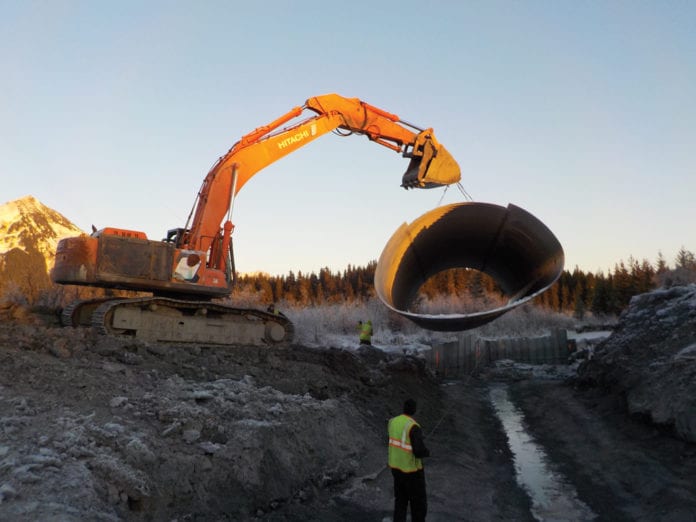
By Kristin S. Carpenter
For The Cordova Times
The Copper River Watershed Project’s most recent effort to update a fish-blocking culvert culminated in December 2016, when an old, tired, and undersized pipe near Milepost 20 on the Copper River Highway was replaced with a fish-friendly stream simulation design.
Juvenile coho salmon and cutthroat trout will now have easier access to 2.5 miles of upstream spawning and rearing habitat, increasing their productivity and supporting subsistence, sport and commercial fishing harvests.

Culvert sounds like a foreign word to me. The Oxford Dictionary defines culvert as “a tunnel carrying a stream or open drain under a road or railway. Origin (of word): unknown. If you were a fish though, you’d be very familiar with culverts, and which ones allow you to get where you want to go and which ones are dead ends.
In the Copper River watershed, we have one culvert for every two miles of road. That ratio is probably even smaller for the Kenai Peninsula and the Mat-Su Valley. The size of the culvert and how it is placed can affect the movement of water, sediment and fish. A culvert that is too small can cause sediment to build up on the upstream end of the pipe, while a culvert that is “perched”, or raised above the level of the stream, can block juvenile and even adult salmon from successfully swimming upstream.
Miles of upstream spawning and rearing habitat, critical to salmon early life stages, can be blocked by a single failed culvert.
Replacing these culverts is important for maintaining valuable fisheries in Southcentral Alaska. The best replacement culverts are large enough to allow for a natural streambed and stream banks within the pipe, so that the culvert acts like a bridge at most water flow levels.
“Salmon move between fresh and saltwater to begin and complete their life cycle, and our coastal communities are built right on top of this transition zone,” explains Jack Sinclair, executive director of the Kenai Watershed Forum. Culverts are so important to salmon reproduction and salmon population productivity that both the Kenai Peninsula and Mat-Su boroughs now have their own ordinances specifying construction standards for design and installation of culverts to provide for adequate fish passage.
Replacing a culvert doesn’t always involve a municipality directly, but it does “take a village” to do the job. When we took our first culvert replacement, I thought “it’s a pipe in the ground. How hard can it be?” We’ve replaced four culverts since then, and now I know. Each culvert project requires a broad team of partners, including adjacent land owners. Some partners we’ve worked with over the past decade on restoring fish passage include sub-dividers, a church, the US Department of Agriculture Forest Service, and homeowners, utilities, and the Alaska Departments of Transportation and Public Facilities and Fish and Game.
We now know the digest is the easy part!
In a way, it’s fitting that these projects require a community effort, because we all benefit.
A 2015 McDowell Group report for the Alaska Salmon Alliance found that Southcentral Alaska “regional fisheries accounted for 13 percent of total statewide ex-vessel value in 2013… The region featured 20 communities with total gross resident fishing earnings greater than $1 million.” Southcentral streams and rivers also produce salmon harvested for subsistence and personal use fishing, the fish in our home freezers.
Our most recent Copper River Highway culvert replacement was made possible thanks to funding from the Alaska Sustainable Salmon Fund, the Alaska Department of Transportation and Public Facilities (for hydrology and engineering services), the Alaska Department of Fish and Game, and Chugach National Forest.
Looking ahead, Copper River Watershed Project will continue to work closely with partner organizations and stakeholders to install additional fish-friendly culverts in the Cordova area and the Copper Basin. To learn more about these efforts and how you can help, visit www.copperriver.org.
Kristin S. Carpenter is the executive director of the Copper River Watershed Project

Photo by Arthur Plumlee, Alaska Department of Transportation and Public facilities














